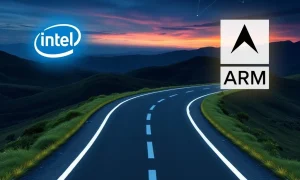The technology landscape constantly evolves. Major shifts are reshaping the semiconductor industry. For Intel, this period is particularly pivotal. The company faces a critical 18-month window. During this time, it must decisively chart its path forward. Otherwise, competitors like Qualcomm and Arm could further solidify their dominance. This article explores the challenges and opportunities defining Intel’s Future.
Understanding Intel’s Future Challenges
Intel has long been a powerhouse in the chip manufacturing world. Its x86 architecture powered most personal computers for decades. It also dominated the data center market. However, the industry is changing rapidly. New architectures and business models are emerging. These developments pose significant threats to Intel’s traditional strongholds.
Several key factors contribute to Intel’s current predicament. Firstly, the rise of Arm-based chips is undeniable. Arm designs offer high power efficiency. This makes them ideal for mobile devices. They are now moving into laptops and servers. Secondly, Qualcomm, a major Arm licensee, is expanding aggressively. It targets markets historically controlled by Intel. Thirdly, Intel’s manufacturing process faced delays. These delays allowed rivals to catch up. They even surpassed Intel in some areas. Consequently, Intel must innovate quickly. It must also execute its strategies flawlessly.
The company’s CEO, Pat Gelsinger, acknowledges these pressures. He has outlined an ambitious turnaround plan. This plan aims to regain technological leadership. It also seeks to diversify Intel’s business. Success depends on rapid execution. It also relies on effective market adaptation. Therefore, the next year and a half are crucial for Intel’s Future trajectory.
The Rise of Arm and Qualcomm’s Ambitions
Arm Holdings designs the instruction sets for most smartphone processors. Its low-power designs are a significant advantage. This advantage extends beyond mobile phones. Many companies now use Arm chips for laptops. Apple’s M-series chips, for instance, are Arm-based. They offer impressive performance and efficiency. This shift challenged Intel’s long-standing dominance in the PC market. Microsoft is also investing heavily in Arm for Windows devices. This further intensifies competition.
Qualcomm is a key player in the Arm ecosystem. It develops Snapdragon processors for mobile devices. Now, Qualcomm is making a strong push into the PC space. Its new Snapdragon X Elite platform promises high performance. It also offers excellent battery life. These chips directly compete with Intel’s Core processors. Furthermore, Qualcomm is targeting the server market. This move directly challenges Intel’s Xeon processors. Qualcomm’s strategy involves:
- Expanding beyond mobile: Diversifying into new computing segments.
- Leveraging Arm’s efficiency: Capitalizing on the power advantages of Arm architecture.
- Partnering with OEMs: Working closely with laptop manufacturers to integrate its chips.
This aggressive expansion by Qualcomm, powered by Arm’s architecture, creates a formidable challenge. It directly impacts Intel’s Future market share. Intel must respond effectively to these evolving threats.
Intel’s Strategic Response: IDM 2.0 and Foundry Services
Intel is not standing still. The company has launched an ambitious strategy called IDM 2.0. This integrated device manufacturing model aims to restore Intel’s manufacturing prowess. It involves significant investments in new fabs. It also includes adopting cutting-edge process technologies. The goal is to regain process leadership. This is vital for Intel’s Future competitiveness. Moreover, Intel is expanding its foundry services. Intel Foundry Services (IFS) will manufacture chips for other companies. This marks a significant shift. Traditionally, Intel primarily made chips for itself. Now, it aims to be a major contract manufacturer. This strategy diversifies its revenue streams. It also helps amortize the massive costs of new fabs. It could also attract new customers. These customers might otherwise turn to TSMC or Samsung.
The success of IDM 2.0 hinges on several factors. Intel must execute its manufacturing roadmap on time. It must also attract significant foundry customers. Furthermore, it needs to innovate faster than its rivals. The company’s ability to deliver on these promises will define its trajectory. Pat Gelsinger emphasizes a renewed focus on engineering excellence. He also stresses a culture of accountability. This transformation is crucial. It will determine whether Intel can reclaim its technological edge.
The Data Center Battleground and AI Acceleration
The data center market is another critical battleground. Intel’s Xeon processors have long dominated this space. However, Arm-based server chips are gaining traction. Companies like Amazon Web Services (AWS) develop their own Arm-based Graviton processors. These chips offer compelling performance-per-watt ratios. This appeals to cloud providers. They seek to optimize operational costs. Nvidia’s Grace CPU, also Arm-based, targets high-performance computing. It integrates with Nvidia’s powerful GPUs. This creates a strong offering for AI workloads.
Artificial intelligence (AI) is driving significant demand for specialized hardware. GPUs are currently leading in AI acceleration. However, Intel is investing in its own AI accelerators. Its Gaudi series of AI chips competes with Nvidia’s offerings. Intel is also integrating AI capabilities into its CPUs. This strategy aims to provide comprehensive solutions. It seeks to cater to diverse AI workloads. The company must demonstrate competitive performance. It also needs to offer compelling total cost of ownership. Only then can it maintain its position. The outcome of this data center and AI battle will heavily influence Intel’s Future financial performance.
Key Strategic Pillars for Intel’s Future Success
Intel’s turnaround strategy rests on several pillars. Each pillar is essential for navigating the competitive landscape. These pillars include:
- Process Leadership: Regaining and maintaining an advantage in chip manufacturing technology. This involves executing its ‘five nodes in four years’ plan.
- Product Innovation: Delivering compelling products across its portfolio. This includes CPUs, GPUs, and AI accelerators.
- Foundry Services Expansion: Building a robust and competitive contract manufacturing business. This attracts external customers.
- Software and Ecosystem: Strengthening its software ecosystem. This ensures developers can easily optimize for Intel hardware.
- Cost Efficiency: Streamlining operations and improving profitability. This allows for sustained investment in R&D.
The next 18 months will reveal the effectiveness of these strategies. Intel must demonstrate tangible progress. It needs to ship products on advanced nodes. It also must secure significant foundry deals. Furthermore, it must show competitive performance in key segments. This period is a true test of its resilience. It will define its long-term viability in the semiconductor industry. Investors and analysts are closely watching. They await clear signs of a successful transformation. The company’s very existence as a dominant force hinges on these efforts. It is a defining moment for Intel’s Future.
The Importance of Execution and Speed
In the fast-paced semiconductor industry, speed is paramount. Product cycles are short. Technological advancements happen rapidly. Intel’s past delays hurt its competitive standing. Now, flawless execution is non-negotiable. The company must accelerate its research and development. It also needs to bring new products to market faster. This includes its next-generation CPUs and GPUs. It also applies to its advanced manufacturing processes. Any further delays could prove catastrophic. They could give rivals an insurmountable lead. The market will not wait for Intel. Therefore, agility and rapid iteration are critical. This directly impacts the viability of Intel’s Future strategies.
Intel is implementing new organizational structures. It aims to foster greater accountability. It also seeks to improve decision-making speed. This cultural shift is as important as technological advancements. It enables the company to respond quickly to market demands. It also helps it adapt to competitive pressures. The leadership team faces immense pressure. They must deliver on ambitious targets. Their success or failure will shape the industry for years to come.
The Stakes for Intel’s Future
The stakes for Intel are incredibly high. The company’s market capitalization is significant. It employs tens of thousands globally. Its technology underpins critical infrastructure worldwide. A successful turnaround would solidify its position. It would also reassure investors. Conversely, failure could lead to further market share erosion. It could also result in reduced profitability. This might force more drastic measures. The outcome of this 18-month period will determine Intel’s role. Will it remain a leader? Or will it become a niche player? The semiconductor industry is a foundation of the digital economy. Intel’s performance has ripple effects. It impacts innovation, employment, and global supply chains. Therefore, the trajectory of Intel’s Future matters to many beyond just its shareholders.
The competitive landscape will only intensify. Arm continues to innovate. Qualcomm seeks new markets. Other players like AMD and Nvidia also push boundaries. Intel must differentiate itself. It must offer unique value propositions. This includes performance, efficiency, and ecosystem support. The next year and a half will be a test. It will show if Intel can rise to the challenge. The entire tech world is watching. They await the outcome of this pivotal period.
Conclusion: A Defining Period for Intel
Intel stands at a critical juncture. The next 18 months will define its trajectory. The company faces aggressive competition from Qualcomm and Arm. It also grapples with internal manufacturing challenges. However, Intel has a strong legacy. It possesses vast resources. Its IDM 2.0 strategy is ambitious. It focuses on regaining technological leadership. It also expands into foundry services. The success of these initiatives hinges on flawless execution. It also depends on rapid innovation. The outcome will determine Intel’s Future. It will decide if Intel remains a dominant force. Or if it cedes more ground to its rivals. This period is a true test of resilience and strategic foresight.
Frequently Asked Questions (FAQs) about Intel’s Future
Q1: What is the main challenge facing Intel’s Future?
A1: Intel’s main challenge is intense competition from Arm-based chip designers like Qualcomm, particularly in the PC and server markets, combined with past delays in its own manufacturing process technology.
Q2: What is Intel’s IDM 2.0 strategy?
A2: IDM 2.0 (Integrated Device Manufacturing 2.0) is Intel’s strategy to regain manufacturing leadership. It involves significant investments in new fabrication plants (fabs) and expanding its Intel Foundry Services (IFS) to manufacture chips for other companies, alongside its own.
Q3: How do Qualcomm and Arm threaten Intel’s Future?
A3: Arm’s energy-efficient architecture is gaining ground in laptops and servers, challenging Intel’s x86 dominance. Qualcomm, a major Arm licensee, is aggressively pushing its Snapdragon chips into these markets, offering competitive performance and battery life.
Q4: What role does AI play in Intel’s Future strategy?
A4: AI is crucial. Intel is investing in its own AI accelerators (e.g., Gaudi series) and integrating AI capabilities into its CPUs. This aims to provide comprehensive solutions for diverse AI workloads and compete with specialized AI hardware providers like Nvidia.
Q5: Why are the next 18 months so critical for Intel?
A5: This 18-month period is critical because it’s the timeframe for Intel to demonstrate tangible progress on its IDM 2.0 strategy, deliver on its manufacturing roadmap, and show competitive product performance to regain market share and investor confidence against rapidly advancing rivals.
























